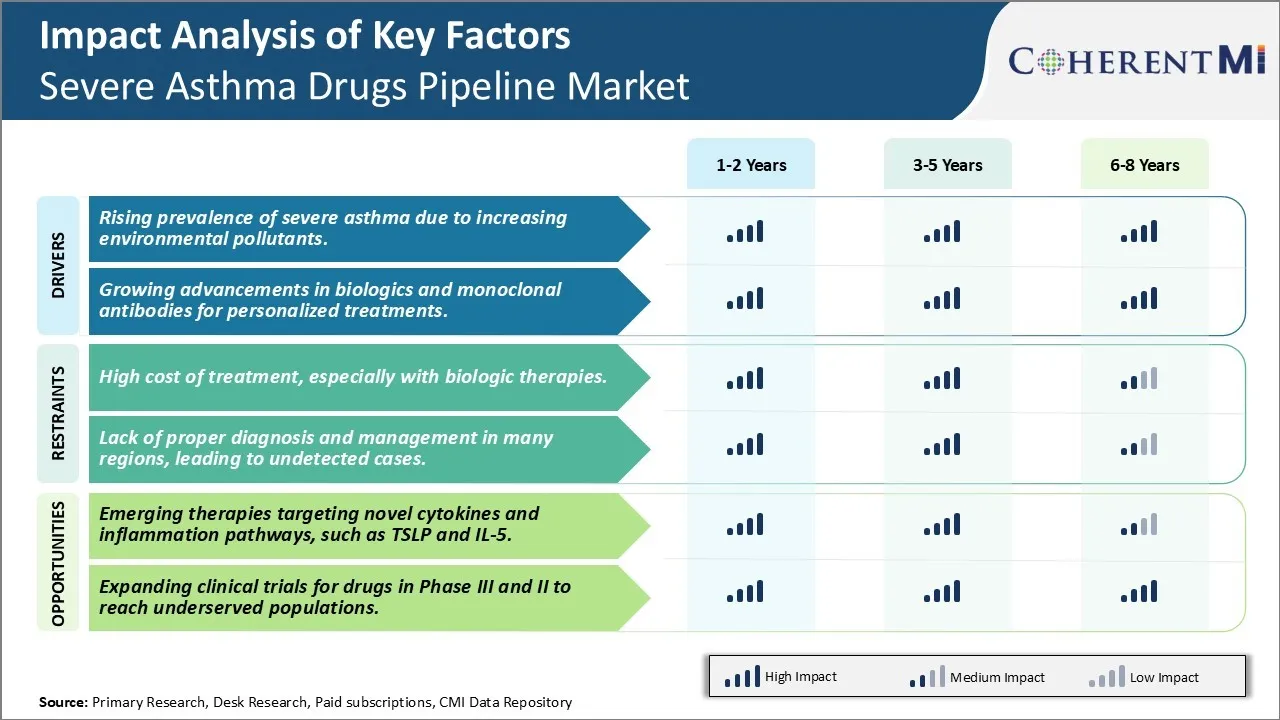Severe Asthma Drugs Market Trends
Market Driver - Rising Prevalence of Severe Asthma Due to Increasing Environmental Pollutants.
With rapid industrialization and urbanization, environmental pollution has become a major issue impacting public health. While outdoor air pollution stems from vehicular emissions, construction activities, power plants indoor air quality is also compromised due to rising use of chemicals, furniture, construction materials and household products that emit toxic fumes. Severe asthmatics are especially vulnerable to effects of pollutants as their lung function is already compromised.
Studies show a direct correlation between rising levels of particulate matter (PM 2.5 and PM 10), ozone, nitrogen dioxide, sulfur dioxide and prevalence of asthma cases especially among children and elderly. These pollutants have the ability the penetrate deeper into the lungs and even bloodstream, causing inflammatory responses. Repeated exposure over time damages the airways and lungs, deteriorating lung function in asthmatics. Allergens and irritants from polluted air also act as triggers, aggravating asthma symptoms. Incidents of acute exacerbations leading to emergency room visits and hospitalizations have seen a conspicuous rise parallel to worsening air quality.
Market Driver - Growing Advancements in Biologics and Monoclonal Antibodies for Personalized Treatments.
The development of targeted biological drug therapies heralds a new era for specialized treatment of severe refractory asthma. Conventional asthma controllers are often inadequate to rein in uncontrolled symptoms among severe asthmatics, calling for novel pharmacological approaches. Monoclonal antibodies that block specific inflammatory pathways implicated in asthma pathology have shown great promise.
Drugmakers are continuously advancing science to develop highly selective biologics attacking molecular triggers of asthma. Compared to traditional 'one size fits all' therapies, these biologics enable personalized care by precisely interfering with Asthma's specific pathological processes in each patient. Drugs inhibiting mediators like IgE, IL-5, IL-4Rα have proved dramatically effective in reducing exacerbations for certain asthma phenotypes. Currently approved mAbs like omalizumab, mepolizumab, reslizumab, benralizumab continue to transform management of severe eosinophilic and allergic asthma.
The booming pipeline includes several new paradigms for targeting emerging inflammatory pathways and phenotypes. These encompass antibodies against IL-33, IL-13, TSLP among others. Combined therapies are also envisioned to offer synergistic Clinical benefits. A major fillip is that biologics are well-tolerated and demonstrate long-term safety. Novel delivery routes now facilitate self-administration outside healthcare settings. These advantages will help escalate the uptake of biologics for asthma care, driving the accompanying market.

Market Challenge - High Cost of Treatment, Especially with Biologic Therapies.
One of the major challenges currently facing the Severe Asthma Drugs Market is the high cost of treatment associated with existing and emerging biologic therapies. Biologics such as monoclonal antibodies that target specific cytokines and inflammatory pathways have revolutionized the treatment of severe refractory asthma over the past decade. However, these biologic drugs often have list prices in the range of USD 20,000 to USD 50,000 per patient annually. The high cost of biologics has imposed significant economic burden on patients as well as healthcare systems globally. Out-of-pocket costs after insurance can still be prohibitive for many patients. Moreover, the high resource requirements to administer biologic injections also increases treatment costs. The sustainability of the severe asthma market is threatened by the increasing pharmaceutical expenditures on high-priced treatments. Drug developers will need to explore strategies such as outcome-based pricing models and expanded patient access programs to make novel therapies more affordable and increase their uptake. However, balancing treatment innovation with cost containment remains a major challenge for the future growth of this market segment.
Market Opportunity - Emerging Therapies Targeting Novel Cytokines And Inflammation Pathways, Such as TSLP and IL-5.
One of the key opportunities for the severe asthma drugs market lies in emerging therapeutics that target novel cytokines and inflammatory pathways implicated in disease pathogenesis. There is ongoing research focused on developing drugs against newer targets such as thymic stromal lymphopoietin (TSLP) and interleukin-5 (IL-5). TSLP has emerged as an important epithelial cytokine that promotes type 2 inflammation. Drugs blocking TSLP signaling could provide an effective treatment option for a significant subset of severe asthma patients. Similarly, targeting the cytokine IL-5, which is a key driver of eosinophilic inflammation, with monoclonal antibodies is a promising novel therapeutic approach. Drugs targeting these and other emerging inflammatory pathways have the potential to significantly enhance therapeutic efficacy for severe asthma compared to existing standard-of-care options. Their selective mechanisms of action may also result in improved safety profiles. This could translate to better patient outcomes and higher treatment compliance. The introduction of effective therapies against novel drug targets is expected to fuel significant growth in the severe asthma drugs market over the next decade.